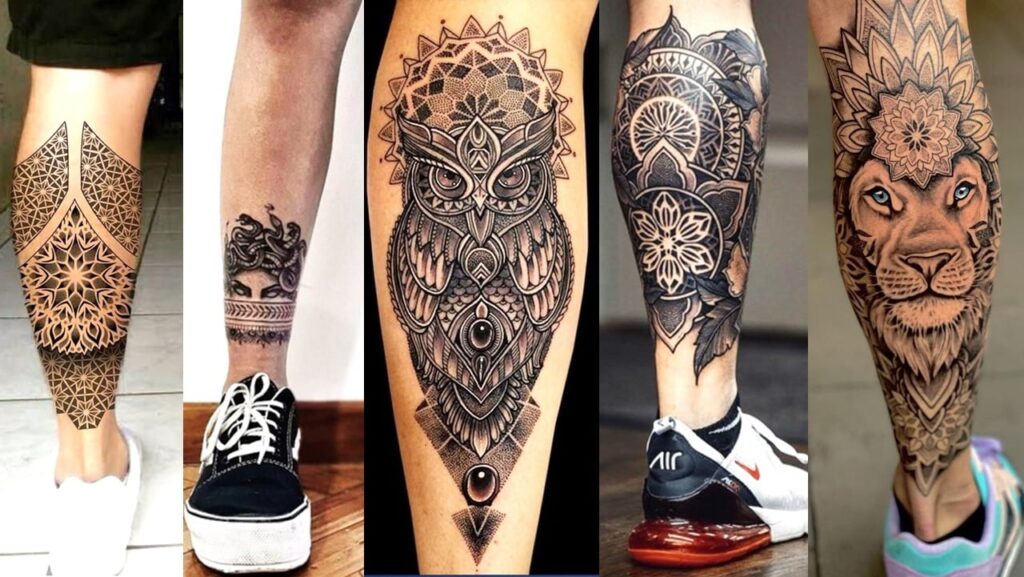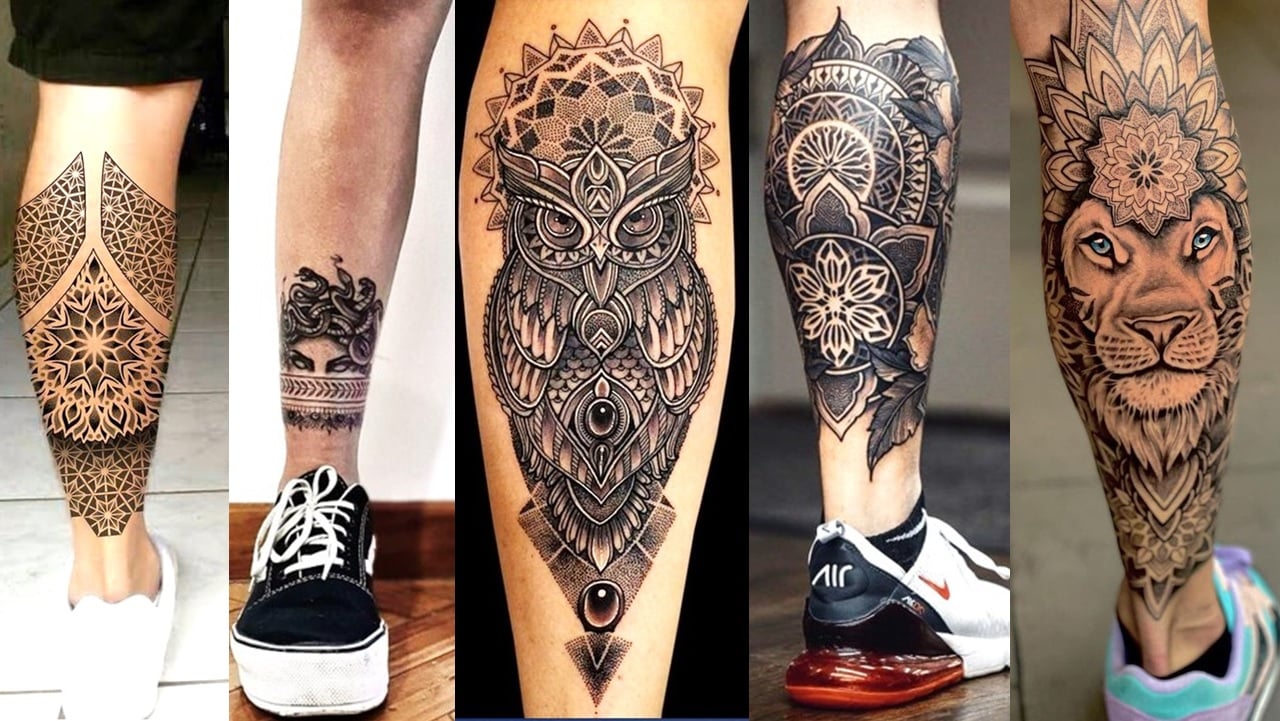
Mens Leg Tattoos: Designs, Placement, and Considerations
The world of body art offers a vast canvas for self-expression, and the leg, with its ample space and visibility, is a popular choice for men seeking to showcase their individuality through mens leg tattoos. From intricate sleeves to subtle single designs, mens leg tattoos allow for a wide range of artistic styles and personal narratives. This article will delve into the diverse world of mens leg tattoos, exploring popular designs, optimal placement, important considerations, and aftercare tips.
Popular Mens Leg Tattoo Designs
The possibilities for mens leg tattoos are virtually limitless, constrained only by imagination and the skill of the tattoo artist. Here are some trending and timeless designs:
- Geometric Patterns: Clean lines and symmetrical shapes create visually striking mens leg tattoos. These can range from simple bands to complex tessellations.
- Tribal Designs: Drawing inspiration from various indigenous cultures, tribal tattoos often feature bold black ink and intricate patterns that hold symbolic meaning.
- Animal Tattoos: Lions, wolves, eagles, and other powerful animals are popular choices, representing strength, courage, and freedom. A fierce lion on the calf can be a powerful statement.
- Biomechanical Tattoos: A fusion of organic and mechanical elements, biomechanical tattoos create a futuristic and visually stunning effect, often depicting robotic or cyborg-like enhancements.
- Japanese-Inspired Tattoos: Dragons, koi fish, samurai, and other traditional Japanese motifs are frequently chosen for their rich symbolism and intricate detail. These mens leg tattoos often cover a large area of the leg.
- Religious Tattoos: Crosses, angels, and other religious symbols can be a deeply personal expression of faith.
- Text and Script Tattoos: Meaningful quotes, lyrics, or names can be incorporated into mens leg tattoos, often in elegant fonts or stylized calligraphy.
- Nautical Tattoos: Anchors, ships, compasses, and other nautical themes are classic choices, often representing adventure, exploration, and a connection to the sea.
Optimal Placement for Mens Leg Tattoos
The placement of a mens leg tattoo is just as important as the design itself. Different areas of the leg offer varying levels of visibility, pain tolerance, and suitability for certain designs.
Thigh Tattoos
The thigh offers a large and relatively flat surface, making it ideal for large, intricate designs. Thigh tattoos can be easily concealed under clothing, providing flexibility for professional settings. The outer thigh generally experiences less pain than the inner thigh.
Calf Tattoos
The calf is another popular placement for mens leg tattoos, offering good visibility and a relatively muscular surface. Calf tattoos can be easily shown off with shorts or pants rolled up. The calf muscle can also accentuate the design.
Ankle Tattoos
Ankle tattoos are more subtle and discreet, suitable for smaller, simpler designs. They can be easily covered with socks or shoes. However, the ankle area can be more sensitive due to the proximity of bone and tendons.
Foot Tattoos
Foot tattoos are a bold choice, often associated with a higher level of pain due to the numerous nerve endings in the area. They are also more prone to fading due to friction from shoes and socks. Careful consideration should be given before opting for a foot tattoo.
Full Leg Sleeves
A full leg sleeve is a comprehensive and ambitious project, covering the entire leg from the thigh to the ankle. It allows for a cohesive and visually stunning display of interconnected designs, often telling a story or representing a specific theme. Leg sleeves require significant time, commitment, and financial investment. [See also: Tattoo Sleeve Ideas for Men]
Factors to Consider Before Getting a Mens Leg Tattoo
Before committing to a mens leg tattoo, several factors should be carefully considered to ensure a positive and lasting experience:
- Pain Tolerance: Pain levels vary depending on the location of the tattoo and individual pain tolerance. Areas with more bone and fewer muscles, such as the ankle and shin, tend to be more painful.
- Design Complexity: Intricate designs require more time and skill from the tattoo artist, which can affect the overall cost.
- Professional Environment: Consider your workplace’s policies regarding visible tattoos. If necessary, choose a placement that can be easily concealed under clothing.
- Skin Tone and Type: Certain tattoo inks may appear differently on different skin tones. Consult with your tattoo artist to choose the best ink colors for your complexion.
- Health Conditions: Individuals with certain medical conditions, such as diabetes or autoimmune disorders, may experience complications with the healing process. Consult with your doctor before getting a tattoo.
- Artist Selection: Research and choose a reputable and experienced tattoo artist whose style aligns with your desired design. Review their portfolio and read client testimonials before booking an appointment.
The Tattoo Process: What to Expect
Understanding the tattoo process can help alleviate anxiety and ensure a smooth experience:
- Consultation: Discuss your design ideas, placement preferences, and any concerns with your chosen tattoo artist. They will provide guidance and create a custom design or modify an existing one.
- Preparation: The artist will shave and cleanse the area to be tattooed. A stencil of the design will be applied to your skin.
- Tattooing: The artist will use a tattoo machine to inject ink into the dermis layer of your skin, following the stencil outline.
- Cleaning and Bandaging: After the tattoo is complete, the artist will clean the area and apply a bandage to protect it from infection.
Aftercare: Ensuring Proper Healing
Proper aftercare is crucial for preventing infection and ensuring the longevity of your mens leg tattoo. Follow these guidelines:
- Keep the Tattoo Clean: Gently wash the tattoo with mild soap and water two to three times a day.
- Apply Aftercare Ointment: Apply a thin layer of aftercare ointment, such as Aquaphor or Hustle Butter, to keep the tattoo moisturized.
- Avoid Sun Exposure: Protect the tattoo from direct sunlight by wearing loose-fitting clothing or applying sunscreen (after the tattoo has fully healed).
- Avoid Soaking the Tattoo: Refrain from swimming, bathing, or using hot tubs until the tattoo is fully healed.
- Don’t Pick or Scratch: Avoid picking or scratching the tattoo, as this can damage the ink and increase the risk of infection.
- Wear Loose Clothing: Avoid tight clothing that can rub against the tattoo and irritate the skin.
- Stay Hydrated: Drinking plenty of water helps keep your skin hydrated and promotes healing.
Potential Risks and Complications
While tattoos are generally safe, there are potential risks and complications to be aware of:
- Infection: Bacterial infections can occur if the tattoo is not properly cared for. Signs of infection include redness, swelling, pain, pus, and fever. Seek medical attention if you suspect an infection.
- Allergic Reactions: Allergic reactions to tattoo ink can cause itching, rash, and swelling. Certain colors, such as red, are more likely to cause allergic reactions.
- Scarring: Excessive scratching or picking can lead to scarring.
- Granulomas: Granulomas are small bumps that can form around the tattoo ink.
- Keloids: Keloids are raised, thickened scars that can develop at the tattoo site.
- Bloodborne Diseases: Using unsterilized equipment can transmit bloodborne diseases, such as hepatitis B, hepatitis C, and HIV. Choose a reputable tattoo artist who follows strict hygiene protocols.
Removing a Mens Leg Tattoo
While tattoos are intended to be permanent, removal is possible through laser tattoo removal. This process involves using lasers to break down the tattoo ink into smaller particles that the body can eliminate. Laser tattoo removal can be expensive and time-consuming, often requiring multiple sessions. The effectiveness of laser tattoo removal depends on factors such as the size, color, and age of the tattoo. [See also: Tattoo Removal Methods and Effectiveness]
Conclusion
Mens leg tattoos offer a unique and expressive way to personalize your body. By carefully considering design options, placement, pain tolerance, and aftercare, you can ensure a positive and lasting experience. Remember to research and choose a reputable tattoo artist, follow proper aftercare instructions, and be aware of potential risks and complications. Whether you opt for a bold leg sleeve or a subtle ankle tattoo, your mens leg tattoo can be a powerful reflection of your individuality and personal story.
Ultimately, the best mens leg tattoos are those that hold personal meaning and resonate with the individual wearing them. Take your time, explore your options, and choose a design that you will be proud to display for years to come. The art of mens leg tattoos is a celebration of self-expression, creativity, and the enduring power of body art.

